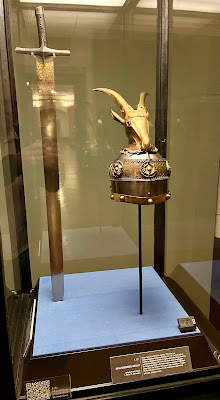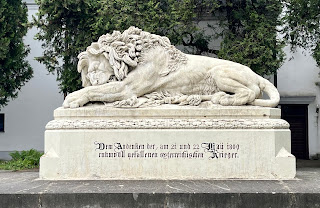I am in Vienna this week. It is not my first visit, but my wife has never been. There are lots of Balkan links, of course, but one battlefield I have never visited is Aspern-Essling. It was fought on 21-22 May 1809, during the War of the Fifth Coalition. I wasn't originally planning to go because the volunteer museums are only open on Sundays. However, the previous day's visit had worn my wife's sprained ankle, so I got a morning pass.
Aspern and Essling were two small villages on the banks of the Danube River near Vienna. Napoleon chose this area for his river crossing, led by Marshal Jean Lannes. They initially faced stiff Austrian resistance but managed to secure a foothold on the far bank. Archduke Charles responded, launching a series of fierce counterattacks to dislodge the French from their positions. The terrain, which included marshes and small villages, posed challenges for both sides. Control of critical positions, such as the villages of Aspern and Essling, shifted repeatedly during the battle. While the battle ended inconclusively, Napoleon withdrew his forces to the original side of the Danube, conceding a rare tactical defeat.

I re-read David Chandler's battle description and brought his maps. However, this was an opportunity to try the new travel guide app Guidl. Charles Esdaile has done a guided tour of this battle, and it was very useful. The app is free, but you pay to download each tour, which is £6.99. For that, you get an overview of the battle and several audio segments you can listen to at critical points on the battlefield. You will also need Google Maps to get about. In my case, by walking and bus. The app is a bit clunky, but Charles clearly explains what happened at each spot and describes the commanders engaged.
So, I caught the train to Aspern, which is over the Danube in today's Vienna suburbs. Then, I took a bus to St Martin's Church, which was on the French left flank. This was a key strong point in the battle and has several monuments, along with a small museum.
I walked towards the old main street, which formed part of the defences. There are still some older houses, and the locals haven't forgotten Napoleon😂.
Next, a short bus ride takes you to Essling. First, out to the open fields of the Marchfeld, scene of Bessieres cavalry charges. The street is named after one of the Austrian commanders.
My final stop was the granary in Essling, which formed the right flank of the French position. It is the one building that survived and is easy to spot. The guide goes on to the river crossings, but I needed to head back to our flat for the afternoon museum visits.
I have refought this battle a few times on the tabletop. It is an interesting tactical challenge, as the French need a bridgehead but are outnumbered at least four to one.
It would have been a better visit with the museums. So, if you have the option, go on a Sunday. However, walking the battlefield is still valuable, and I will enjoy the next game all the more.
The previous day, we visited the Belvedere Palace, which has the classic Napoleon crossing the Alps painting. It's historical nonsense, as he actually crossed the Alps on a mule (a realistic painting is in Liverpool's Walker Gallery), but it's a great painting. The Hofburg also has a fine statue of Archduke Charles. The Austrians do like statues; the city is littered with them.
As a postscript, I also made a quick visit to Wagram later in the week. There is a small museum (open Sundays only) in what was the Archduke's HQ. I didn't have time to walk the Austrian line down to Markgrafneusiedl, and there is no public transport.

















































